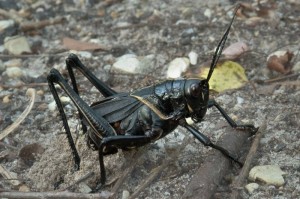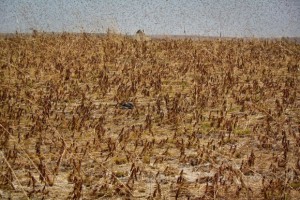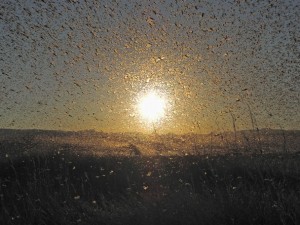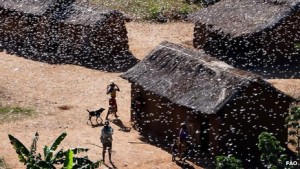A plague of locusts has been feared throughout history. Even after all these years, locusts continue to wreak havoc. In many ways, locusts are like harmless little grasshoppers. They eat plants and they hop long distances on springy back legs.  Their lifestyle may be solitary, similar to that of grasshoppers. However, locust behavior can be something else entirely. They have another behavioral phase called the gregarious phase. Just one locust can’t cause trouble. The problem is, sometimes, locusts gather in big groups or swarms. When environmental conditions favour the growth of many green plants and promote breeding, locusts can congregate into thick, mobile, ravenous swarms. In an astoundingly short period of time, they can completely destroy a crop; nuisance for commercial agriculture, but life-threatening for subsistence farmers. Dr. Steve Rogers of Cambridge University says, “The gregarious phase is a strategy born of desperation and driven by hunger – swarming is a response to find pastures new.”
Their lifestyle may be solitary, similar to that of grasshoppers. However, locust behavior can be something else entirely. They have another behavioral phase called the gregarious phase. Just one locust can’t cause trouble. The problem is, sometimes, locusts gather in big groups or swarms. When environmental conditions favour the growth of many green plants and promote breeding, locusts can congregate into thick, mobile, ravenous swarms. In an astoundingly short period of time, they can completely destroy a crop; nuisance for commercial agriculture, but life-threatening for subsistence farmers. Dr. Steve Rogers of Cambridge University says, “The gregarious phase is a strategy born of desperation and driven by hunger – swarming is a response to find pastures new.”
An approaching swarm of locusts looks like a big black cloud. As the swarm descends, the insects eat everything in sight – garden crops, grass, flowers, and even clothes hanging on a clothes line. In poor desert countries, families can starve after locusts eat all their food. A swarm of locusts can stretch over 460 square miles in size and include billions of hungry insects! Locust swarms  may devastate crops and cause major agricultural damage; ultimately causing famine and starvation. Each locust can eat its weight in plants each day, so a swarm of such size would eat around 423 million pounds of plants each day. When these insects alight on the ground, they immediately begin to devour the grass and grain, eating every green thing they can find. Adult locusts will potentially eat any vegetation that is green, or even partially green. The bigger the swarm, greater will be the damage caused. Although the young hoppers cannot fly, they march in bands, eating the crops in their path. Swarming locusts can fly almost 80 kilometers a day, and they may travel several 1000 kilometers before they settle to breed.
may devastate crops and cause major agricultural damage; ultimately causing famine and starvation. Each locust can eat its weight in plants each day, so a swarm of such size would eat around 423 million pounds of plants each day. When these insects alight on the ground, they immediately begin to devour the grass and grain, eating every green thing they can find. Adult locusts will potentially eat any vegetation that is green, or even partially green. The bigger the swarm, greater will be the damage caused. Although the young hoppers cannot fly, they march in bands, eating the crops in their path. Swarming locusts can fly almost 80 kilometers a day, and they may travel several 1000 kilometers before they settle to breed.
Locust swarms occur in many parts of the world, but today they are most destructive in the sustenance farming regions of Africa. The destruction of crops has a devastating effect on people. Although locust swarms do not affect humans directly, they could cause death due to famine and starvation. Cases of crop destruction due to locusts are ubiquitous. In 2004, West and North Africa experienced their largest infestation of locusts in more than 15 years. Desert locusts swept across Sahel from Mauritania to Egypt, and then continued as far as Israel in the east and as far as Portugal in the north. Half the crops of Mauritania were lost as a result of this infestation. In 2004, Australian plague locusts were responsible for national agricultural losses estimated to be worth more than $11 mil lion. In November 2008, a locust swarm 3.7 miles long devastated agricultural production in Australia. A swarm of an estimated 30 million locusts had descended on Egypt. The insects descended on agricultural farms in Giza and in Cairo, causing damage of catastrophic proportions.
lion. In November 2008, a locust swarm 3.7 miles long devastated agricultural production in Australia. A swarm of an estimated 30 million locusts had descended on Egypt. The insects descended on agricultural farms in Giza and in Cairo, causing damage of catastrophic proportions.
The following article will explain just how destructive locusts can be:
Madagascar hit by ‘severe’ plague of locusts
Published on 27 March 2013
 A severe plague of locusts has infested about half of Madagascar, threatening crops and raising concerns about food shortages, a UN agency says.
A severe plague of locusts has infested about half of Madagascar, threatening crops and raising concerns about food shortages, a UN agency says.
The UN’s Food and Agricultural Organization (FAO) said billions of the plant-devouring insects could cause hunger for 60% of the population.
About $22m (£14.5m) was urgently needed to fight the plague in a country where many people are poor, the FAO added.
It was the worst plague to hit the island since the 1950s, the FAO said.
FAO locust control expert Annie Monard told BBC Focus on Africa the plague posed a major threat to the Indian Ocean Island.
“The last one was in the 1950s and it had duration of 17 years so if nothing is done it can last for five to 10 years, depending on the conditions,” she said.
“Currently, about half the country is infested by hoppers and flying swarms – each swarm made up of billions of plant-devouring insects,” the FAO said in a statement.
“FAO estimates that about two-thirds of the island country will be affected by the locust plague by September 2013 if no action is taken.”
It said it needed donors to give more than $22m in emergency funding by June so that a full-scale spraying campaign could be launched to fight the plague.
The plague threatened pasture for livestock and rice crops – the main staple in Madagascar, the FAO said.
“Nearly 60% of the island’s more than 22m people could be threatened by a significant worsening of hunger in a country that already had extremely high rates of food insecurity and malnutrition,” it added.
An estimated 80% of people in Madagascar, which has a population of more than 22 million, live on less than a dollar a day.
The Locust Control Centre in Madagascar had treated 30,000 hectares of farmland since last October, but a cyclone in February made the situation worse, the FAO said.
The cyclone not only damaged crops but created “optimal conditions for one more generation of locusts to breed”, it added.
There are very few solutions available to combat a modern-day plague of locusts; many farmer burn branches to create smoke in the hopes of driving the insects out, but this technique is not always effective. Insecticides are sometimes used to control locusts, but this method is hazardous and may cause long-lasting consequences to the crops and humans who consume them.
Hence to help alleviate or else completely eradicate the infestation we C Tech Corporation provide you with the best effective solution Combirepel™. Combirepel™ is an anti-insect aversive developed on the grounds of green chemistry and technology.
Our product works on the mechanism of repellency. It temporarily inhibits the mating cycle of the insects. The product impairs the ability of the insects to reproduce, that is the insects will not lay eggs or the laid eggs will be infertile. The product causes feeding disruption in an insect by triggering an unpleasant reaction within the insect which might try to feed on the application. The product temporarily blocks the reproduction system of the insects by hindering the release of the vital hormones for growth.
Combirepel™ is thermally stable and does not degrade on exposure to heat and sunlight. It does not kill or harm the insect but repels them. It does not volatilize and does not degrade the soil. It is RoHS, RoHS2, ISO, REACH, APVMA, NEA compliant and FIFRA exempted.
Combirepel™ is an eco-friendly product which acts as an aversive to repel the pesky insects like roaches. Combirepel™ do not kill the targeted as well as non-targeted species but just repel them causing no harm no to human and environment.
Combirepel™ is available in the form of masterbatch, liquid concentrate, and lacquer. Our Combirepel™ masterbatch can be used in polymer base applications like wires, cables, irrigation pipes, polymeric vessels, and other various applications.
Combirepel™ liquid concentrate can be mixed in the paints to cover the areas like cracks and crevices of walls and hidden places where the roaches tend to survive.
Combirepel™ lacquer is the topical coating to cover the places like bathrooms, cupboards, steam tunnels, etc.
Hence we provide you with the best effective solution.
Contact us as technical.marketing@ctechcorporation.com to get solution on pest nuisance.
Also, visit our websites:
http://www.ctechcorporation.com/
http://www.rodrepel.com/
http://www.termirepel.com/
http://www.combirepel.com/
Follow our Facebook pages at:
1] https://www.facebook.com/Combirepel-411710912249274/
2] https://www.facebook.com/Termirepel-104225413091251/
3] https://www.facebook.com/Rodrepel-120734974768048/
Follow us on our Twitter pages at:
1] https://twitter.com/rodrepel
2] https://twitter.com/termirepel
3] https://twitter.com/combirepel
